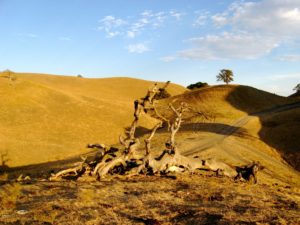This strenuous 5.3-mile hike circumambulates Mount Diablo’s summit, and traverses many of the mountain’s geological and botanical features. When I was there in early April 2006, the air was startlingly clear, and the snowy masses of the Sierra Nevada and Mount Lassen floated all along the eastern and northern horizons, while the watery realm of the Delta seemed close enough to touch. The clear air also provided a stunning view of the urbanization that besets the mountain, not only to the west, where most towns are, but on all sides, including the Central Valley, where massive blocks of new housing looked odd among bright green fields and pastures.
The hike starts at the summit’s lower parking lot, and follows the Summit Trail southeast to Devil’s Elbow, then keeps turning left around the summit via the North Peak Trail to Prospector’s Gap, the Bald Ridge Trail, the Meridian Ridge Road, and Deer Flat Road to Juniper Camp, returning to the parking lot via the Juniper Trail. (There is a total climb of 1,820 feet, much of it steep and rocky.)
The trails pass over the Jurassic and Cretaceous deposits that Whitney identified in 1865. Tectonic pressures have squeezed and twisted the rocks into such tortured shapes it is hard to imagine their origin on the flat Pacific ocean floor. Impressive red outcrops of radiolarian chert dominate at Devil’s Pulpit. Slick green serpentinite along the Deer Flat trail originated when plate movements scraped up mantle material and mixed it with ocean water before squeezing it up toward the surface. Undersea eruptions created the greenish, dome-shaped pillow basalts visible along the Juniper Trail.
Myriad variations of chaparral occur on the rocky, exposed summit, so the hike is a great chance to get acquainted with it and its odd creatures. When I started through the heavy brush along the Summit Trail, a California thrasher ran in front of me, a shy, long-billed bird that lives only in chaparral. It sings like the mockingbird, to which it is closely related. There’s also a chance of seeing rarer creatures like the endangered Alameda whipsnake, an extraordinarily slender snake that flashes past almost before you can see it. Shrub species are surprisingly diverse, from scattered clumps of California sagebrush, creambush, and poison oak to dense, tall tangles of scrub oak, silktassel, and buckbrush. Another common shrub in the chaparral on the peak’s north side is hop tree, a mildly allergenic relative of poison oak with hop-shaped fruits and lime-green, tripartite leaves.
The summit’s exposed, rocky terrain challenges other plant communities, forcing them to adapt. Their foliage shifts and whispers uneasily in the relentless summit winds. Only a few riparian plants like bigleaf maple have been able to grow along the steep creeks, which are virtual waterfalls in spring, but dry stony staircases for most of the year. The broadleaf-sclerophyll community occupies shady spots, but wind and shallow soil stunt the laurels and canyon live oaks into a dwarf forest. The deciduous oak-pine community occurs as scattered trees, with drought-resistant pines and another gymnosperm, western juniper, predominating over oaks.
Sparse grasslands on exposed ridges and unstable slopes feature many native wildflowers because the poor soil discourages exotics. Flower displays change from day to day. Baby blue eyes and goldfields were common on my April walk. A hiker a few weeks later reported bright patches of goldenbush and California poppy, with wiry bird’s-eye gilias carpeting some sites. Many flowers seem to grow happily from bare rock. In early spring, bright orange-yellow wallflowers, related to wild mustard, occupy sandstone outcrops, and miniature gardens of pink-flowered Claytonia (a relative of miner’s lettuce) and Allium (wild onion) brighten scree fields. In summer, yellow sulfur buckwheat and scarlet hummingbird fuchsia bloom profusely despite infernal temperatures.

.jpg)


-300x221.jpg)
-300x201.jpg)